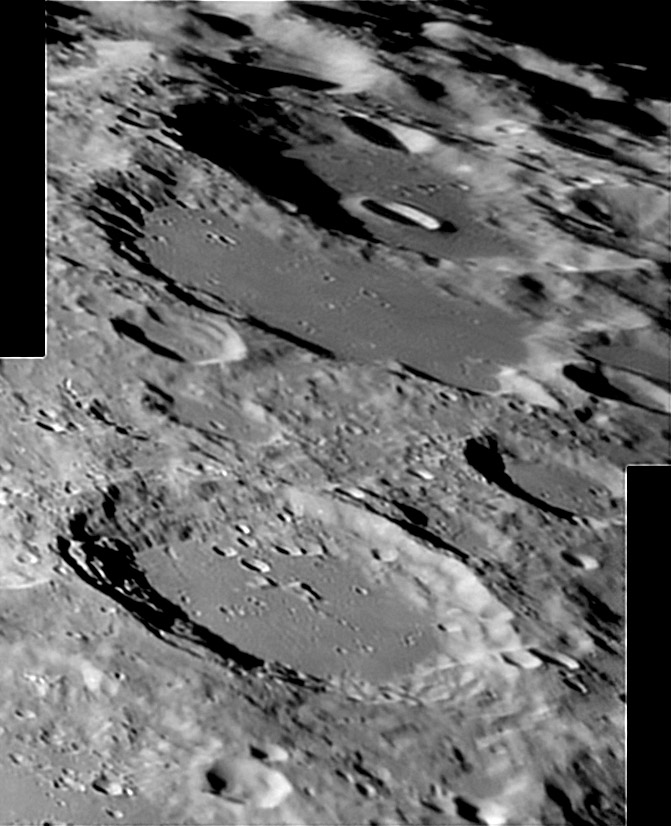|
|
| (3 intermediate revisions by the same user not shown) |
| Line 1: |
Line 1: |
| | __NOTOC__ | | __NOTOC__ |
| | =Three in a Row= | | =Three in a Row= |
| | + | <!-- Start of content --> |
| | <div class="post" id="post-1420"> | | <div class="post" id="post-1420"> |
| | | | |
| Line 6: |
Line 7: |
| | <p>[[File:Klaproth-etc-Salway-LPOD.jpg|Klaproth-etc-Salway-LPOD.jpg]]<br /> | | <p>[[File:Klaproth-etc-Salway-LPOD.jpg|Klaproth-etc-Salway-LPOD.jpg]]<br /> |
| | <em>image by [mailto:MSalway@hutchison.com.au Mike Salway], Australia; south up</em></p> | | <em>image by [mailto:MSalway@hutchison.com.au Mike Salway], Australia; south up</em></p> |
| − | <p>Finding your way toward either pole is sometimes a little tricky because of craters that look similar. North and west of the lunar south pole are two very distinctive craters that I use to check bearings. [http://the-moon.wikispaces.com/Klaproth Klaproth] (diameter 119 km) and slightly smaller (111 km) [http://the-moon.wikispaces.com/Casatus Casatus] are easy to identify because they have broad flat floors and they slightly overlap. Casatus has a small bright crater on its interior, Casatus C, and “J” is an older one, but bright in this light, cutting the southern rim. The foreground crater is [http://the-moon.wikispaces.com/Blancanus Blancanus], whose eastern floor and rim are dappled with a line of small secondary craters that point toward the bottom right toward Moretus. The mountains near the bottom of the frame look bold because of the low lighting, but also because some are parts of the [http://www.lpod.org/?m=20061021 rim] of the farside [http://www.lpod.org/?m=20060920 South Pole - Aitken Basin].</p> | + | <p>Finding your way toward either pole is sometimes a little tricky because of craters that look similar. North and west of the lunar south pole are two very distinctive craters that I use to check bearings. [https://the-moon.us/wiki/Klaproth Klaproth] (diameter 119 km) and slightly smaller (111 km) [https://the-moon.us/wiki/Casatus Casatus] are easy to identify because they have broad flat floors and they slightly overlap. Casatus has a small bright crater on its interior, Casatus C, and “J” is an older one, but bright in this light, cutting the southern rim. The foreground crater is [https://the-moon.us/wiki/Blancanus Blancanus], whose eastern floor and rim are dappled with a line of small secondary craters that point toward the bottom right toward Moretus. The mountains near the bottom of the frame look bold because of the low lighting, but also because some are parts of the [[October_21,_2006|rim]] of the farside [[September_20,_2006|South Pole - Aitken Basin]].</p> |
| | <p align="right"><em>Chuck Wood</em></p> | | <p align="right"><em>Chuck Wood</em></p> |
| | <p><strong>Technical Details:</strong><br /> | | <p><strong>Technical Details:</strong><br /> |
| Line 13: |
Line 14: |
| | Rükl plate 72<br /> | | Rükl plate 72<br /> |
| | [http://www.iceinspace.com.au Mike’s website]<br /> | | [http://www.iceinspace.com.au Mike’s website]<br /> |
| − | [http://www.lpod.org/?m=20060805 Klaproth redoux]</p> | + | [[August_5,_2006|Klaproth redoux]]</p> |
| | <p><b>Yesterday's LPOD:</b> [[September 28, 2007|Shining Light on the Alps]] </p> | | <p><b>Yesterday's LPOD:</b> [[September 28, 2007|Shining Light on the Alps]] </p> |
| | <p><b>Tomorrow's LPOD:</b> [[September 30, 2007|Mirageful Moonset]] </p> | | <p><b>Tomorrow's LPOD:</b> [[September 30, 2007|Mirageful Moonset]] </p> |
| − | <!-- Removed reference to store page --> | + | <!-- Removed reference to store page 2 --> |
| | </div> | | </div> |
| | + | <!-- End of content --> |
| | {{wiki/ArticleFooter}} | | {{wiki/ArticleFooter}} |




